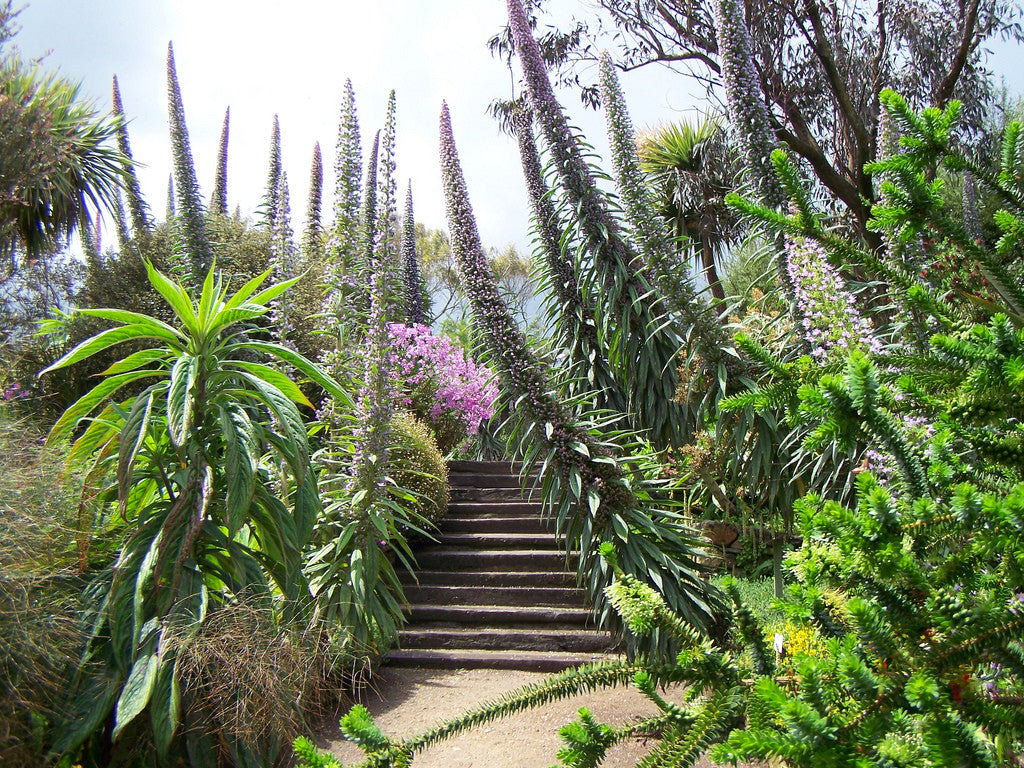 Probably the drama queen of the Echiums...
Probably the drama queen of the Echiums...
 Echium pininana, also called Tree Echium and Giant
Viper's bugloss, is a plant, native to La Palma in the Canary Islands.
E. pininana is a biennial or triennial, showing little more than leaf
in the first year, but subsequently produces a dense, 10-12 ft high
(potentially) flower spike that carries a dense mass of leaves and small
blue flowers. Attracts many Hummingbirds, Bees, Butterflies.
Echium pininana, also called Tree Echium and Giant
Viper's bugloss, is a plant, native to La Palma in the Canary Islands.
E. pininana is a biennial or triennial, showing little more than leaf
in the first year, but subsequently produces a dense, 10-12 ft high
(potentially) flower spike that carries a dense mass of leaves and small
blue flowers. Attracts many Hummingbirds, Bees, Butterflies.
The tree echium is a showy plant, that will withstand negative temperatures down to 26°F - 25°F (-3°C to -4°C) - zone 8+
Inflorescence of the tree echium appears in the beginning of the second
spring. Resembling a Palm tree, the stem quickly reaches up to 10-12 ft
tall, and bears numerous tiny blue-violet flowers.
Certainly the most sought-after of all Echium species that will bring crowds flocking to see it. Stunning!
Seeds...
Panax quinquefolius roots have become a very popular herbal medicine, especially in China. As a result of its over-exploitation and the loss of its natural forest habitat, it is now rare in the wild, and material used commercially has to come from cultivated plants. It is now considered to be a threatened species in 16 states and endangered in a further 10 states.
American ginseng (Xi Yang Shen), Panax quinquefolius. The word "panax" comes from the Greek word "pan" meaning "all", and the Greek "akos" meaning "cure", or "cure all", which exemplifies the high regard for this herb.
Ginseng plants have glossy green leaves and grow to about 2 feet tall and wide.
They have a thin, single stem that emerges from the top of the root that shrinks each year as the plant grows. This causes wrinkles or rings at the top, or neck, of the root and is the most accurate way to date the age of a ginseng root after harvest.
In most climates seedlings are best grown in a deep pot in a greenhouse or cold frame for the first winter, then can be planted in a permanent location in late summer. The plant is perennial and hardy to USDA zone 6. Prefers moist humus rich soil in semi shade to full shade.
Pre-chilled, already stratified Seeds

 Echium pininana, also called Tree Echium and Giant
Viper's bugloss, is a plant, native to La Palma in the Canary Islands.
Echium pininana, also called Tree Echium and Giant
Viper's bugloss, is a plant, native to La Palma in the Canary Islands. 














